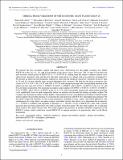ORBITAL PHASE VARIATIONS OF THE ECCENTRIC GIANT PLANET HAT-P-2b
Author(s)
Knutson, Heather A.; Showman, Adam P.; Cowan, Nicolas B.; Laughlin, Gregory; Burrows, Adam; Deming, Drake; Crepp, Justin R.; Mighell, Kenneth J.; Agol, Eric; Bakos, Gaspar A.; Charbonneau, David; Desert, Jean-Michel; Fischer, Debra A.; Fortney, Jonathan J.; Hartman, Joel D.; Hinkley, Sasha; Howard, Andrew W.; Johnson, John Asher; Kao, Melodie M.; Langton, Jonathan; Marcy, Geoffrey W.; Lewis, Nikole; ... Show more Show less
DownloadLewis-2013-ORBITAL PHASE VARIAT.pdf (5.432Mb)
PUBLISHER_POLICY
Publisher Policy
Article is made available in accordance with the publisher's policy and may be subject to US copyright law. Please refer to the publisher's site for terms of use.
Terms of use
Metadata
Show full item recordAbstract
We present the first secondary eclipse and phase curve observations for the highly eccentric hot Jupiter HAT-P-2b in the 3.6, 4.5, 5.8, and 8.0 μm bands of the Spitzer Space Telescope. The 3.6 and 4.5 μm data sets span an entire orbital period of HAT-P-2b (P = 5.6334729 d), making them the longest continuous phase curve observations obtained to date and the first full-orbit observations of a planet with an eccentricity exceeding 0.2. We present an improved non-parametric method for removing the intrapixel sensitivity variations in Spitzer data at 3.6 and 4.5 μm that robustly maps position-dependent flux variations. We find that the peak in planetary flux occurs at 4.39 ± 0.28, 5.84 ± 0.39, and 4.68 ± 0.37 hr after periapse passage with corresponding maxima in the planet/star flux ratio of 0.1138% ± 0.0089%, 0.1162% ± 0.0080%, and 0.1888% ± 0.0072% in the 3.6, 4.5, and 8.0 μm bands, respectively. Our measured secondary eclipse depths of 0.0996% ± 0.0072%, 0.1031% ± 0.0061%, 0.071% [+0.029% over -0.013%], and 0.1392% ± 0.0095% in the 3.6, 4.5, 5.8, and 8.0 μm bands, respectively, indicate that the planet cools significantly from its peak temperature before we measure the dayside flux during secondary eclipse. We compare our measured secondary eclipse depths to the predictions from a one-dimensional radiative transfer model, which suggests the possible presence of a transient day side inversion in HAT-P-2b's atmosphere near periapse. We also derive improved estimates for the system parameters, including its mass, radius, and orbital ephemeris. Our simultaneous fit to the transit, secondary eclipse, and radial velocity data allows us to determine the eccentricity (e = 0.50910 ± 0.00048) and argument of periapse (ω = 188°.09 ± 0°.39) of HAT-P-2b's orbit with a greater precision than has been achieved for any other eccentric extrasolar planet. We also find evidence for a long-term linear trend in the radial velocity data. This trend suggests the presence of another substellar companion in the HAT-P-2 system, which could have caused HAT-P-2b to migrate inward to its present-day orbit via the Kozai mechanism.
Date issued
2013-03Department
Massachusetts Institute of Technology. Department of Earth, Atmospheric, and Planetary SciencesJournal
Astrophysical Journal
Publisher
IOP Publishing
Citation
Lewis, Nikole K., Heather A. Knutson, Adam P. Showman, Nicolas B. Cowan, Gregory Laughlin, Adam Burrows, Drake Deming, et al. “ORBITAL PHASE VARIATIONS OF THE ECCENTRIC GIANT PLANET HAT-P-2b.” The Astrophysical Journal 766, no. 2 (March 13, 2013): 95. © 2013 The American Astronomical Society
Version: Final published version
ISSN
0004-637X
1538-4357